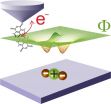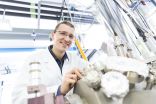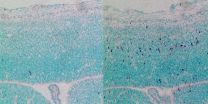Down to the quantum dot
Jülich researchers develop ultrahigh-resolution 3-D microscopy technique for electric fields
2015-07-07
(Press-News.org) This news release is available in German.
Jülich, 7 July - Using a single molecule as a sensor, scientists in Jülich have successfully imaged electric potential fields with unrivalled precision. The ultrahigh-resolution images provide information on the distribution of charges in the electron shells of single molecules and even atoms. The 3D technique is also contact-free. The first results achieved using "scanning quantum dot microscopy" have been published in the current issue of Physical Review Letters. The related publication was chosen as the Editor's suggestion and selected as a Viewpoint in the science portal Physics. The technique is relevant for diverse scientific fields including investigations into biomolecules and semiconductor materials.
"Our method is the first to image electric fields near the surface of a sample quantitatively with atomic precision on the sub-nanometre scale," says Dr. Ruslan Temirov from Forschungszentrum Jülich. Such electric fields surround all nanostructures like an aura. Their properties provide information, for instance, on the distribution of charges in atoms or molecules.
For their measurements, the Jülich researchers used an atomic force microscope. This functions a bit like a record player: a tip moves across the sample and pieces together a complete image of the surface. To image electric fields up until now, scientists have used the entire front part of the scanning tip as a Kelvin probe. But the large size difference between the tip and the sample causes resolution difficulties - if we were to imagine that a single atom was the same size as a head of a pin, then the tip of the microscope would be as large as the Empire State Building.
Single molecule as a sensor
In order to improve resolution and sensitivity, the scientists in Jülich attached a single molecule as a quantum dot to the tip of the microscope. Quantum dots are tiny structures, measuring no more than a few nanometres across, which due to quantum confinement can only assume certain, discrete states comparable to the energy level of a single atom.
The molecule at the tip of the microscope functions like a beam balance, which tilts to one side or the other. A shift in one direction or the other corresponds to the presence or absence of an additional electron, which either jumps from the tip to the molecule or does not. The "molecular" balance does not compare weights but rather two electric fields that act on the mobile electron of the molecular sensor: the first is the field of a nanostructure being measured, and the second is a field surrounding the tip of the microscope, which carries a voltage.
"The voltage at the tip is varied until equilibrium is achieved. If we know what voltage has been applied, we can determine the field of the sample at the position of the molecule," explains Dr. Christian Wagner, a member of Temirov's Young Investigators group at Jülich's Peter Grünberg Institute (PGI-3). "Because the whole molecular balance is so small, comprising only 38 atoms, we can create a very sharp image of the electric field of the sample. It's a bit like a camera with very small pixels."
Universally applicable
A patent is pending for the method, which is particularly suitable for measuring rough surfaces, for example those of semiconductor structures for electronic devices or folded biomolecules. "In contrast to many other forms of scanning probe microscopy, scanning quantum dot microscopy can even work at a distance of several nanometres. In the nanoworld, this is quite a considerable distance," says Christian Wagner. Until now, the technique developed in Jülich has only been applied in high vacuum and at low temperatures: essential prerequisites to carefully attach the single molecule to the tip of the microscope.
"In principle, variations that would work at room temperature are conceivable," believes the physicist. Other forms of quantum dots could be used as a sensor in place of the molecule, such as those that can be realized with semiconductor materials: one example would be quantum dots made of nanocrystals like those already being used in fundamental research.
INFORMATION:
ELSE PRESS RELEASES FROM THIS DATE:
2015-07-07
A yearlong study of first-time smartphone users by researchers at Rice University and the U.S. Air Force found that users felt smartphones were actually detrimental to their ability to learn.
The research paper "You Can Lead a Horse to Water But You Cannot Make Him Learn: Smartphone Use in Higher Education" appeared in a recent edition of the British Journal of Educational Technology. The research reveals the self-rated impact of smartphones among the users.
"Smartphone technology is penetrating world markets and becoming abundant in most college settings," said Philip ...
2015-07-07
Today in Nature Communications, scientists at the Institute for Research in Biomedicine (IRB Barcelona) provide molecular details about Seckel Syndrome, a rare disease that causes microcephaly, or small brain, and growth delays. A joint study conducted by Travis Stracker and Jens Lüders indicates that the protein CEP63 plays a key role during brain development as it is involved in the correct division of stem cells in this organ. Furthermore, the researchers have discovered that CEP63 is associated with sperm production--an unknown function until now.
Rescuing microcephaly ...
2015-07-07
This news release is available in Spanish. Mikel Zubizarreta, a member of the UPV/EHU's IT 781-13 group, highlights the advantages of timber in building works: "Although it is not as tough as other materials used in structures, it is a better insulator, in other words, it is more energy-efficient and less dense so the structure weighs less. On the other hand, timber is a renewable material -trees are planted and grown and forests are a CO2 sink- and is abundant in the Basque Country (nearly 55% of its surface area consists of forests)."
Yet timber is used much less ...
2015-07-07
PHILADELPHIA - Many people believe that phase I trials with healthy volunteers are very risky and because they pose risks with no benefits, unethical. But how risky are such trials? Less than 1% of 11,000 healthy volunteers who participated in 394 phase I trials for new drugs experienced serious complications, according to a new meta-analysis of participants in non-cancer, phase I medication trials. In addition, none of the volunteers died or suffered persistent disabilities linked to the experimental drugs. In the largest study of its kind, researchers found only 34 (0.31%) ...
2015-07-07
Washington, D.C. - July 6, 2015 - Those bacteria that require iron walk a tightrope. Iron is essential for their growth, but too much iron can damage DNA and enzymes through oxidation. Therefore, bacteria have machinery to maintain their intracellular iron within a range that is healthy for them. Now Theresa D. Ho, PhD, and Craig D. Ellermeier, PhD shed new light on how the pathogen, Clostridium difficile, which is the most common cause of hospital-acquired infectious diarrhea, regulates iron. The research is published online ahead of print July 6 in the Journal of Bacteriology, ...
2015-07-07
While nitrous oxide gas has been used recreationally and medically for more than 200 years - originally for its euphoric and then for its pain relieving and anesthetic properties - the mechanism behind its effects on the brain has been poorly understood. A report from investigators at Massachusetts General Hospital (MGH) finds that the EEG patterns of patients receiving high doses of nitrous oxide differ significantly from those of the same patients when they had received ether-based inhaled anesthetics earlier in the procedures, findings that - along with suggesting how ...
2015-07-07
WASHINGTON, July 7, 2015 - In 1962, an underground fire started in the coal-mining town of Centralia, Pennsylvania. Fifty-three years later, that fire still burns. In this week's episode of Reactions, we explain the history and science behind the Centralia mine fire. Does anyone still live there? How could the fire keep burning for so long, and why hasn't it been extinguished? From a chemical standpoint, what is fire, anyway? It's all answered in our latest video: https://youtu.be/fsgqy5FYP2c.INFORMATION:
Subscribe to the series at http://bit.ly/ACSReactions, and follow ...
2015-07-07
HONOLULU - Aspirin may inhibit the growth of mesothelioma, an aggressive and deadly asbestos-related cancer, University of Hawai'i Cancer Center researchers have found.
The finding could eventually give doctors and patients a potential new tool to fight against this devastating disease, which kills about 3,200 people a year nationwide, and advance knowledge of how to fight other cancers.
The study published in Cell Death and Disease showed that aspirin slows down the growth of mesothelioma by blocking the carcinogenic effects of the inflammatory molecule, High-Mobility ...
2015-07-07
Researchers have developed a new design for a cloaking device that overcomes some of the limitations of existing "invisibility cloaks." In a new study, electrical engineers at the University of California, San Diego have designed a cloaking device that is both thin and does not alter the brightness of light around a hidden object. The technology behind this cloak will have more applications than invisibility, such as concentrating solar energy and increasing signal speed in optical communications.
"Invisibility may seem like magic at first, but its underlying concepts ...
2015-07-07
University of Adelaide researchers are developing a laser system for fast, non-invasive, onsite breath analysis for disease, potentially enabling screening for a range of diseases including diabetes, infections and various cancers in the future.
The researchers have developed an instrument they equate to an "optical dog's nose" which uses a special laser to measure the molecular content of a sample of gas.
"Rather than sniffing out a variety of smells as a dog would, the laser system uses light to "sense" the range of molecules that are present in the sample," says ...
LAST 30 PRESS RELEASES:
[Press-News.org] Down to the quantum dot
Jülich researchers develop ultrahigh-resolution 3-D microscopy technique for electric fields





